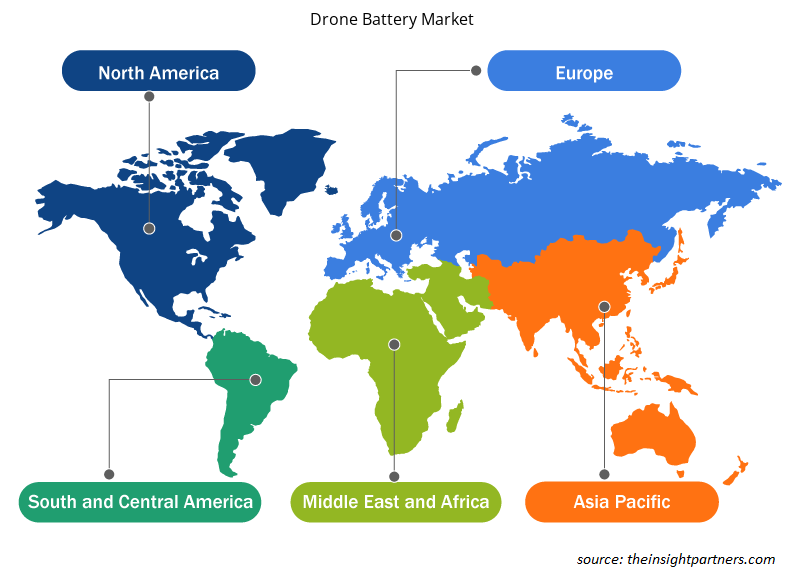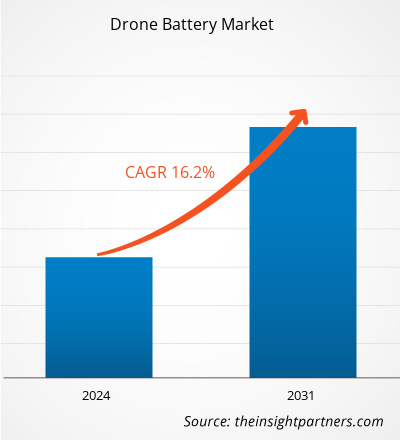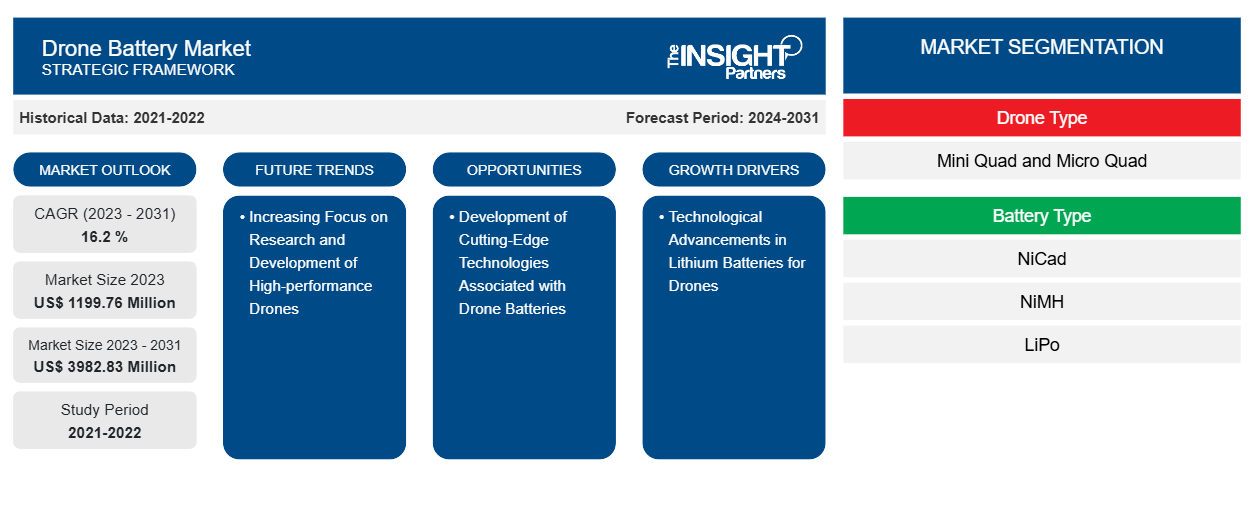Der Markt für Drohnenbatterien soll von 1.199,76 Millionen US-Dollar im Jahr 2023 auf 3.982,83 Millionen US-Dollar im Jahr 2031 anwachsen. Der Markt wird zwischen 2023 und 2031 voraussichtlich eine durchschnittliche jährliche Wachstumsrate (CAGR) von 16,2 % verzeichnen. Die zunehmende Konzentration auf Forschung und Entwicklung von Hochleistungsdrohnen dürfte ein wichtiger Trend auf dem Markt bleiben.CAGR of 16.2 % during 2023–2031. Increasing focus on research and development of high-performance drones is likely to remain a key trend in the market.
Drohnenbatterie-Marktanalyse
Der globale Markt für Drohnenbatterien wird vor allem durch die zunehmende Nutzung von Drohnen in einer Vielzahl von Anwendungen wie Vermessung, Kartierung und Überwachung angetrieben. Darüber hinaus treibt die steigende Zahl von Drohnen-Start-up-Unternehmen die Expansion des Drohnenbatteriemarktes weltweit voran. So stieg beispielsweise die Gesamtzahl der Drohnen-Start-ups in Indien zwischen August 2021 und Februar 2022 um 34 %. Solche Faktoren bieten Chancen für den Drohnenbatteriemarkt in Indien.
Marktübersicht für Drohnenbatterien
Drohnenbatterien sind wiederaufladbare Batterien, die für Drohnen verwendet werden können. Sie bestehen im Allgemeinen aus Lithium-Ionen-Polymer (Li-Ion) oder Lithium-Polymer (LiPo) und sind in verschiedenen Größen und Kapazitäten erhältlich. Drohnenbatterien sind für längere Flugzeiten erforderlich und stellen bei unsachgemäßer Handhabung eine mögliche Brandgefahr dar. Der von Ihrer Drohne verwendete Batterietyp kann ein wichtiger Faktor für die Funktionsweise der Drohne sein, einschließlich der Ladezeit zwischen den Einsätzen und der Entladerate. Die am häufigsten verwendeten Drohnenbatterien sind Lithium-Polymer-Batterien (LiPo), Nickel-Cadmium-Batterien (NiCad) und Lithium-Ionen -Batterien (Li-Ion).LiPo) and come in various sizes and capacities. Drone batteries are necessary for longer flight times, and they pose a possible fire hazard if not properly handled. The type of batteries your drone uses can be an important factor in how the drone functions, including the time it takes to charge between uses and the rate of discharge. The most widely used drone batteries are Lithium Polymer (LiPo), Nickel Cadmium (NiCad), and
Passen Sie diesen Bericht Ihren Anforderungen an
Sie erhalten kostenlos individuelle Anpassungen an jedem Bericht, einschließlich Teilen dieses Berichts oder einer Analyse auf Länderebene, eines Excel-Datenpakets sowie tolle Angebote und Rabatte für Start-ups und Universitäten.
-
Holen Sie sich die wichtigsten Markttrends aus diesem Bericht.Dieses KOSTENLOSE Beispiel umfasst eine Datenanalyse von Markttrends bis hin zu Schätzungen und Prognosen.
Treiber und Chancen auf dem Drohnenbatteriemarkt
Technologische Fortschritte bei Lithiumbatterien für Drohnen
Drohnen haben in den letzten Jahren weltweit ein bemerkenswertes Wachstum erlebt. Aufgrund der erhöhten Grenzsicherheit und des Eindringens feindlicher Personen konzentrieren sich mehrere Regierungen und Unternehmen auf die Beschaffung von UAVs. So meldete die Federal Aviation Administration (FAA) im Jahr 2022, dass im Jahr 2023 in den USA 855.860 Drohnen registriert waren. Daher wird erwartet, dass der Batteriemarkt mit der steigenden Nachfrage nach Drohnen im Prognosezeitraum weiterhin deutlich wachsen wird. Darüber hinaus unterstützen auch zunehmende länderspezifische Drohnenverbände wie die kürzlich gegründete Czech Unmanned Aerial Alliance, die Association du Drone de l'industrie française (ADIF) in Frankreich und zahlreiche andere in Asien, darunter die Korea Drone Industry Association, die Korea Drone Association, die Shenzhen UAV Industry Association und die Japan UAS Industrial Development Association, das Wachstum des Drohnenbatteriemarktes.UAVs. For instance, in 2022, the Federal Aviation Administration (FAA) reported that 855,860 drones were registered in the US in 2023. Therefore, with the increasing demand for drones, the battery market is expected to continue to grow significantly during the forecast period. Further, increasing country-specific l’Association du drone de l’industrie française (ADIF) in France, and numerous others in Asia, including Korea Drone Industry Association, the Korea Drone Association, Shenzhen UAV Industry Association, and the Japan UAS Industrial Development Association is also supplementing the growth of drone battery market.
Entwicklung von Spitzentechnologien im Zusammenhang mit Drohnenbatterien
Die Marktteilnehmer entwickeln kontinuierlich Batterien mit geringerem Innenwiderstand, indem sie ihre Ladespannung erhöhen. Diese Batterien werden Drohnen mit höherer Dichte, höherer Zellkapazität, geringerer Masse und maximaler Leistungsdichte unterstützen, die für längere Flugzeiten erforderlich ist. Hersteller wie Amprius Technologies und KULR TECHNOLOGY GROUP, INC. entwickeln außerdem Batterien der nächsten Generation mit einer Energiedichte von 400 Wh/kg und einem Lade-/Entladezyklus von mindestens 1.000 Mal. Daher wird erwartet, dass die Entwicklung hochmoderner Technologien im Zusammenhang mit Drohnenbatterien im Prognosezeitraum lukrative Möglichkeiten für Marktwachstum schaffen wird.Amprius Technologies and KULR TECHNOLOGY GROUP, INC. are also developing next-generation batteries with an energy density of 400 Wh/kg and a charge/discharge cycle of at least 1,000 times. Thus, the development of cutting-edge technologies associated with drone batteries is anticipated to generate lucrative opportunities for market growth during the forecasted period.
Segmentierungsanalyse des Drohnenbatterie-Marktberichts
Wichtige Segmente, die zur Ableitung der Marktanalyse für Drohnenbatterien beigetragen haben, sind Drohnentyp, Batterietyp, Batteriekapazität und Branche.
- Basierend auf dem Drohnentyp ist der Markt für Drohnenbatterien in Mini-Quad und Micro-Quad unterteilt. Das Mini-Quad-Segment hatte im Jahr 2023 einen größeren Marktanteil.
- Nach Batterietyp ist der Markt in NiCad, NiMH und LiPo segmentiert.NiCad, NiMH, and LiPo.
- Nach Batteriekapazität ist der Markt in unter 3.000 mAh, 3.000–5.000 mAh, 5.000–10.000 mAh und über 10.000 mAh segmentiert.mAh, 3,000-5,000 mAh, 5,000-10,000 mAh, and Above 10,000 mAh.
- Nach Branchen ist der Markt in Land- und Forstwirtschaft, Infrastrukturinspektion, Versorgungsunternehmen, Bauwesen, Bergbau und Sonstige unterteilt.
Drohnenbatterie-Marktanteilsanalyse nach geografischer Lage
Der geografische Umfang des Marktberichts für Drohnenbatterien ist hauptsächlich in fünf Regionen unterteilt: Nordamerika, Asien-Pazifik, Europa, Naher Osten und Afrika sowie Süd- und Mittelamerika.
Nordamerika dominiert den Markt für Drohnenbatterien. Diese Investitionen und Finanzierungen sollen Drohnenanbietern helfen, ihr Geschäft auszubauen und Endnutzern aus verschiedenen Sektoren Lösungen anzubieten. Die wachsende Nachfrage nach Drohnen treibt den Bedarf an Batterien in Nordamerika an, was dem Markt für Drohnenbatterien in der Region wahrscheinlich zugute kommen wird.
Regionale Einblicke in den Drohnenbatteriemarkt
Die regionalen Trends und Faktoren, die den Drohnenbatteriemarkt während des Prognosezeitraums beeinflussen, wurden von den Analysten von Insight Partners ausführlich erläutert. In diesem Abschnitt werden auch die Marktsegmente und die Geografie des Drohnenbatteriemarkts in Nordamerika, Europa, im asiatisch-pazifischen Raum, im Nahen Osten und Afrika sowie in Süd- und Mittelamerika erörtert.

- Erhalten Sie regionale Daten zum Drohnenbatteriemarkt
Umfang des Marktberichts für Drohnenbatterien
| Berichtsattribut | Details |
|---|---|
| Marktgröße im Jahr 2023 | 1199,76 Millionen US-Dollar |
| Marktgröße bis 2031 | 3982,83 Millionen US-Dollar |
| Globale CAGR (2023 - 2031) | 16,2 % |
| Historische Daten | 2021-2022 |
| Prognosezeitraum | 2024–2031 |
| Abgedeckte Segmente |
Nach Drohnentyp
|
| Abgedeckte Regionen und Länder |
Nordamerika
|
| Marktführer und wichtige Unternehmensprofile |
|
Marktdichte von Drohnenbatterien: Auswirkungen auf die Geschäftsdynamik verstehen
Der Markt für Drohnenbatterien wächst rasant, angetrieben durch die steigende Nachfrage der Endnutzer aufgrund von Faktoren wie sich entwickelnden Verbraucherpräferenzen, technologischen Fortschritten und einem größeren Bewusstsein für die Vorteile des Produkts. Mit steigender Nachfrage erweitern Unternehmen ihr Angebot, entwickeln Innovationen, um die Bedürfnisse der Verbraucher zu erfüllen, und nutzen neue Trends, was das Marktwachstum weiter ankurbelt.
Die Marktteilnehmerdichte bezieht sich auf die Verteilung der Firmen oder Unternehmen, die in einem bestimmten Markt oder einer bestimmten Branche tätig sind. Sie gibt an, wie viele Wettbewerber (Marktteilnehmer) in einem bestimmten Marktraum im Verhältnis zu seiner Größe oder seinem gesamten Marktwert präsent sind.
Die wichtigsten auf dem Markt für Drohnenbatterien tätigen Unternehmen sind:
- AMIT Industries LTD
- Amperex Technology Limited
- Autel Robotics
- MMC-UAV
- SES AI Corporation
- Parrot Drone SAS
Haftungsausschluss : Die oben aufgeführten Unternehmen sind nicht in einer bestimmten Reihenfolge aufgeführt.

- Überblick über die wichtigsten Akteure auf dem Drohnenbatteriemarkt
Neuigkeiten und aktuelle Entwicklungen zum Drohnenbatteriemarkt
Der Markt für Drohnenbatterien wird durch die Erhebung qualitativer und quantitativer Daten nach Primär- und Sekundärforschung bewertet, die wichtige Unternehmensveröffentlichungen, Verbandsdaten und Datenbanken umfasst. Nachfolgend sind einige der Entwicklungen auf dem Markt für Drohnenbatterien aufgeführt:
- Um Lieferengpässen vorzubeugen, hat die RRC Power Solutions GmbH eine Dual-Sourcing-Strategie eingeführt. Die Strategie hilft dem Unternehmen, bestehende Standard-Akkupacks wie den RRC2054 weiterzuentwickeln und Produkteinführungen mit kürzeren Lieferzeiten zu planen. (Quelle: RRC Power Solutions GmbH, Pressemitteilung, Mai 2022.)
- EaglePicher Technologies lieferte wichtige Batterietechnologie, um sowohl das Besatzungsmodul des Raumfahrzeugs Orion als auch das Flugabbruchsystem Space Launch System (SLS) mit Strom zu versorgen, das beim Start von Artemis I der NASA verwendet wurde. EaglePicher Technologies liefert wiederaufladbare 120-Volt-Lithium-Ionen-Batterien, die das Besatzungsmodul mit Strom versorgen, das aus Kommunikation, Antrieb, Navigation und Wärmekontrolle besteht. (Quelle: EaglePicher Technologies, Pressemitteilung, August 2023)
Marktbericht zu Drohnenbatterien – Abdeckung und Ergebnisse
Der Bericht „Marktgröße und Prognose für Drohnenbatterien (2021–2031)“ bietet eine detaillierte Analyse des Marktes, die die folgenden Bereiche abdeckt:
- Drohnenbatteriemarktgröße und -prognose auf globaler, regionaler und Länderebene für alle wichtigen Marktsegmente, die im Rahmen des Berichts abgedeckt sind
- Markttrends für Drohnenbatterien sowie Marktdynamik wie Treiber, Einschränkungen und wichtige Chancen
- Detaillierte PEST/Porters Five Forces- und SWOT-Analyse
- Marktanalyse für Drohnenbatterien mit Blick auf wichtige Markttrends, globale und regionale Rahmenbedingungen, wichtige Akteure, Vorschriften und aktuelle Marktentwicklungen
- Branchenlandschaft und Wettbewerbsanalyse, einschließlich Marktkonzentration, Heatmap-Analyse, prominenten Akteuren und jüngsten Entwicklungen auf dem Markt für Drohnenbatterien
- Detaillierte Firmenprofile
- Historische Analyse (2 Jahre), Basisjahr, Prognose (7 Jahre) mit CAGR
- PEST- und SWOT-Analyse
- Marktgröße Wert/Volumen – Global, Regional, Land
- Branchen- und Wettbewerbslandschaft
- Excel-Datensatz
Aktuelle Berichte
Verwandte Berichte
Erfahrungsberichte
Grund zum Kauf
- Fundierte Entscheidungsfindung
- Marktdynamik verstehen
- Wettbewerbsanalyse
- Kundeneinblicke
- Marktprognosen
- Risikominimierung
- Strategische Planung
- Investitionsbegründung
- Identifizierung neuer Märkte
- Verbesserung von Marketingstrategien
- Steigerung der Betriebseffizienz
- Anpassung an regulatorische Trends























 Kostenlose Probe anfordern für - Markt für Drohnenbatterien
Kostenlose Probe anfordern für - Markt für Drohnenbatterien